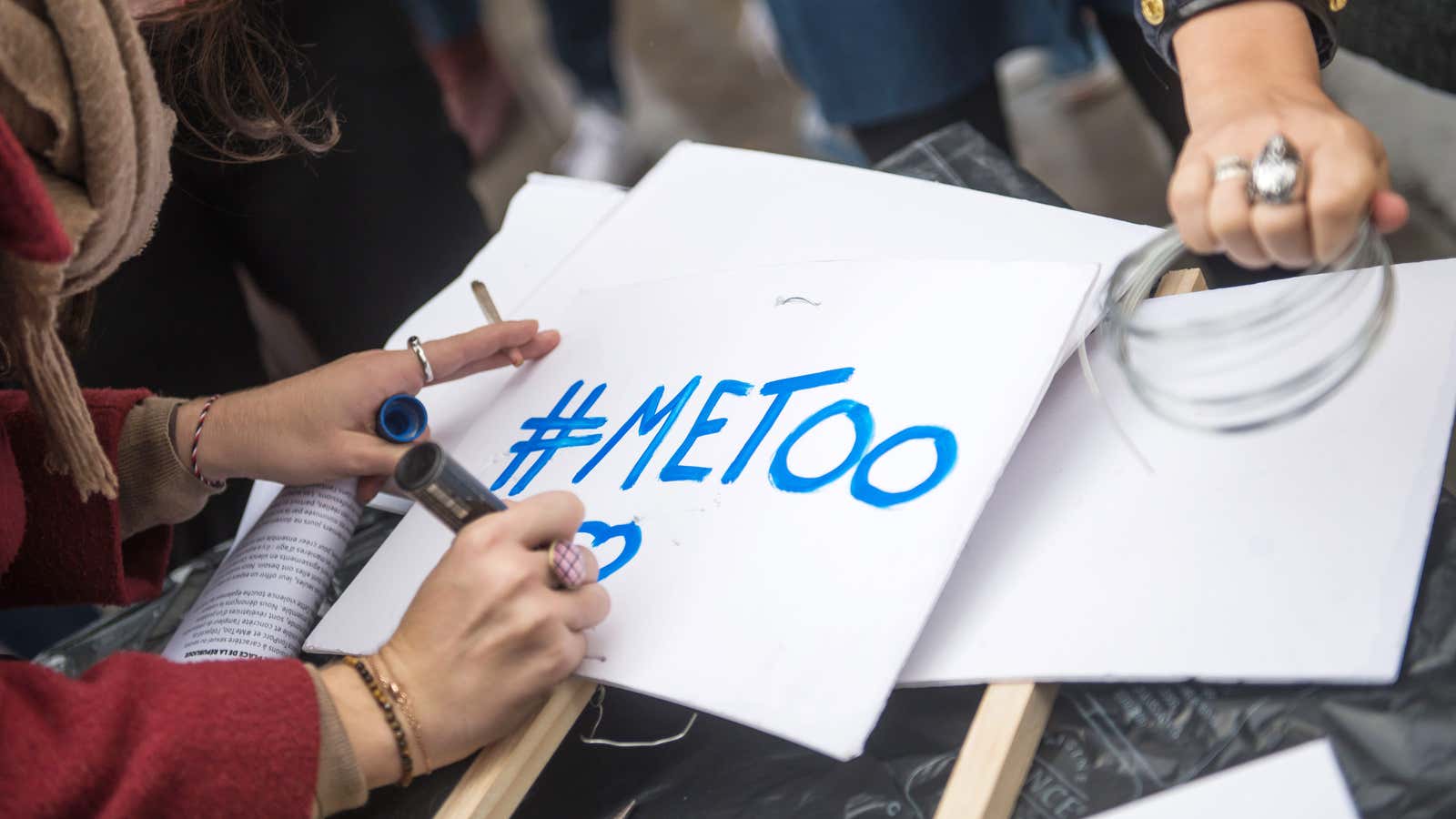In her rousing speech at the Golden Globes, Oprah Winfrey said “speaking your truth is the most powerful tool we all have.”
Invoking the story of Recy Taylor, a 24-year-old African-American sharecropper who was raped by six white men in 1944, and fought for justice with the help of Rosa Parks, Winfrey added: “For too long women have not been heard or believed if they dared to speak their truth to the power of those men. But their time is up. Their time is up!”
This week, women in media have seen that abstract notion—that “speaking your truth is the most powerful tool we all have”—in action, with the creator of what’s known as the “Shitty Media Men List” coming forward.
The anonymously created, crowdsourced Google spreadsheet was essentially a physical manifestation of a whisper network, listing the names of men in media, along with allegations ranging from flirting to rape. At the top was a disclaimer: “This document is only a collection of misconduct allegations and rumors. Take everything with a grain of salt.”
The list was first circulated privately, and anyone with a link could access it anonymously. Its existence became public knowledge before long, after a story on Buzzfeed by Doree Shafrir. (This was about the media, after all.) What had briefly been a tool—one women could use to access information vital to their safety, without judgement—quickly became a story. And it was a good story, one that demonstrated how deeply flawed the process of reporting workplace sexual assault is, and how industries built on networking and relationships, such as Hollywood and media, are particularly prone to abuse. Also, hypocrisy.
Weaponizing the “Shitty Media Men List”
But that didn’t remain the story for long. Within less than a week, Mike Cernovich, a right-wing blogger and men’s-rights activist the New Yorker called “the meme mastermind of the alt-right” was offering a $10,000 bounty for a copy of the list. He then published the names of two men that appeared on it, along with the unsubstantiated claims against them. After it reached Cernovich, it made its way to Reddit. By then, the original list had already been taken offline but remained visible in screenshots and re-creations, as reported by Madison Malone Kircher for Select All in October:
The list is no longer even theoretically a tool for helping women. It’s now being leaked and distributed not to protect women from predators but to publicly attack the men on it. The list has been weaponized for the online culture wars, and the women who created it, contributed to it, and were intended as its readers left totally powerless and voiceless as it’s used to undermine the industry in which they work.
This week, the “Shitty Men” list reappeared on our Twitter feeds, thanks to rumors that Katie Roiphe, an author known for her early 1990s-era dismissal of what she called the “rape crisis movement,” would be outing the list’s creator in the March issue of Harper’s magazine. Outrage ensued. Nicole Cliffe, a writer and the cofounder of the feminist website The Toast, publicly offered writers compensation if they pulled pieces from Harper’s—and help placing them with competing publications. At least one advertiser cancelled business. Harper’s editors refused to comment on what was in the contents of the upcoming issue, but in an email interview with The New York Times, Roiphe denied she would name the list’s creator against their wishes.
No one knew what would happen. Would Harper’s cut the name from Roiphe’s story, and pretend it was never there? Was it ever there in the first place?
Moira Donegan steps forward
Then, on Wednesday night, the creator of the list took back the power and named herself, in a first-person essay published on The Cut, entitled, “I Started the Media Men List. My name is Moira Donegan.”
With 3,000 elegant words, Donegan—a former editor at The New Republic who has written for publications including The New Yorker and the London Review of Books—told her story: why she created the spreadsheet, the thorny questions it raised, the fear she felt when it took on a life of its own, and most of all, the shock at its utter necessity:
Watching the cells populate, it rapidly became clear that many of us had weathered more than we had been willing to admit to one another. There was the sense that the capacity for honesty, long suppressed, had finally been unleashed. This solidarity was thrilling, but the stories were devastating. I realized that the behavior of a few men I had wanted women to be warned about was far more common that I had ever imagined. This is what shocked me about the spreadsheet: the realization of how badly it was needed, how much more common the experience of sexual harassment or assault is than the opportunity to speak about it.
Donegan referred back to a piece she wrote in April for The New Yorker, in which she was skeptical of the power of “feminist storytelling,” and reconsidered her viewpoint.
“The experience of making the spreadsheet has shown me that it is still explosive, radical, and productively dangerous for women to say what we mean,” she wrote. “Like a lot of feminists, I think about how women can build power, help one another, and work toward justice. But it is less common for us to examine the ways we might wield the power we already have. Among the most potent of these powers is the knowledge of our own experiences.”
How brave, how powerful, of Donegan to share her own.
